Full window version (looks a little nicer). Click <Back>
button to get back to small framed version with content indexes.
This material (and images) is copyrighted!.
See my copyright
notice for fair use practices.
Many people believe that astronomers want to build telescopes on tall
mountains or put them in space, so they can be ``closer'' to the objects they
are observing. This is INcorrect! The nearest star is over 41,500,000,000,000
kilometers (26 trillion miles) away. If you ignore the 300-million kilometer
variation in the distances due to the Earth's motion around the Sun and the
12,756-kilometer variation due to the Earth's rotation, being 4 kilometers
closer on a tall mountain amounts to a difference of at most 1 ×
10-11 percent. Telescopes in space get up to 1 ×
10-9 percent closer (again ignoring the much larger variations of the
Earth's orbit around the Sun and the telescope's orbit around the Earth). These
are extremely small differences---the distances to the even the nearest stars
are around 100,000's times greater than the distances between the planets in our
solar system. The reason large telescopes are built on tall mountains or put
in space is to get away from the distortion of starlight due to the
atmosphere.
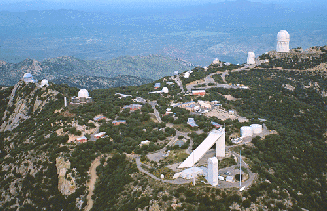 The famous observing site
at the Kitt Peak National
Observatory has many large telescopes including the 4-meter Mayall telescope
(top right) and the McMath Solar Telescope (triangular one at the lower right).
Although it is over 60 kilometers from Tucson, AZ, light pollution from the
increasing population of that city has stopped the construction of any more
telescopes on the mountain.
The famous observing site
at the Kitt Peak National
Observatory has many large telescopes including the 4-meter Mayall telescope
(top right) and the McMath Solar Telescope (triangular one at the lower right).
Although it is over 60 kilometers from Tucson, AZ, light pollution from the
increasing population of that city has stopped the construction of any more
telescopes on the mountain.
The Mauna Kea Observatory is
probably the best observing site in the world. Many very large telescopes are at
the 4177-meter summit of the extinct volcano. Because of the elevation, the
telescopes are above most of the water vapor in the atmosphere, so infrared
astronomy can be done. Kitt Peak's elevation of 2070 meters is too low for
infrared telescopes.
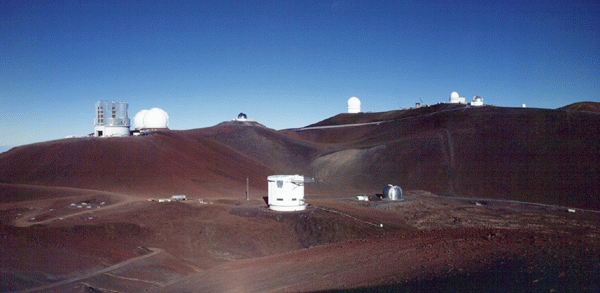
The James C. Maxwell Telescope is in the center front
of this picture of the Mauna Kea Observatory. The two white Keck 10-meter
telescopes are to the left on the ridgetop next to the silver 8.3-meter Subaru
telescope. Select the image to go to the Mauna Kea Observatory homepage.
The air is constantly in turbulent motion and
light from celestial objects is bent randomly in many ways over time periods of
tens of milliseconds. Images dance about (twinkle) and images are blurred. The
atmospheric blurring distorts the view of astronomical objects much as ripples
in water distort the objects below the surface. This atmospheric effect is
called seeing.
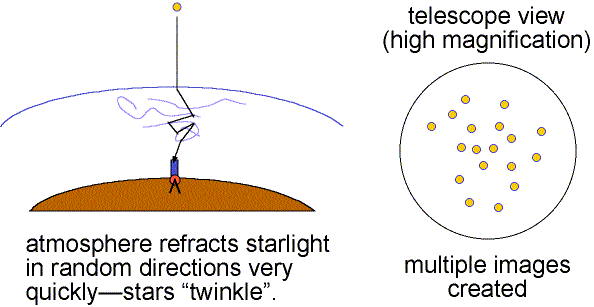
The short animation
shows how light from a star is refracted in random directions by rapidly-moving
pockets of air of varying densities and temperatures. The light reaches
different parts of the telescope's objective from slightly different directions
and different times. A highly magnified view shows multiple images of the star
that dance about in the field of view many times a second, so a second or longer
exposure picture will show a fuzzy blob (called the ``seeing disk'') the size of
the entire distribution of dancing images. An actual observation shows much more
rapid variation and more images of the star. A movie
(mpeg format) of a binary star is available by selecting this
link. The data is from the William Herschel 4.2-meter Telescope in La Palma,
Chile and is courtesy of the Applied
Optics Group at Imperial College. Links to other movies are available there.
Good seeing is when the air is stable (little turbulence) and the twinkling
is small. Details as small as 0.5 arc seconds can be seen when the seeing is
good (still much larger than the theoretical resolving power of large research
telescopes). Poor seeing happens when the air is turbulent so the images dance
about and details smaller than 2 to 3 arc seconds cannot be seen. The more
atmosphere there is above a telescope, the greater is the turbulent motion and
the poorer is the seeing. This is one reason why research telescopes are located
on very high mountains.
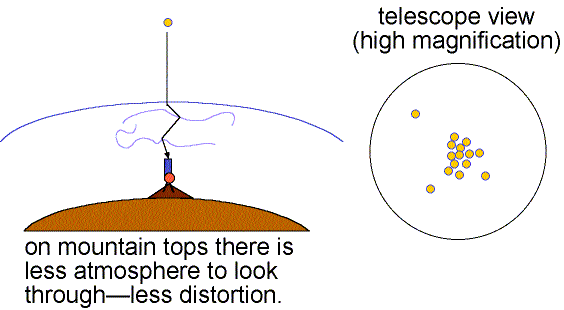
Speckle interferometry can get rid of atmospheric distortion by taking
many fast exposures of an object. Each fraction-of-a-second exposure freezes the
motion of the object. Extensive computer processing then shifts the images to a
common center and removes other noise and distortions caused by the atmosphere,
telescope, and electronics to build up a distortion-free image. See Chris
Koresko's thesis for further exploration of speckle interferometry. Another
technique called adaptive optics makes quick changes in the light path of
the optics to compensate for the atmospheric turbulence. Before the focussed
light from the objective reaches the camera, it bounces off a thin deformable
mirror that can be adjusted thousands of times a second to reposition the
multiple images back to the center. An excellent site to explore this topic
further is the Center for
Astronomical Adaptive Optics web site. A comparison of speckle
interferometry and adaptive optics is at Koresko's Starfire infrared
imaging site.

Telescopes in orbit like the Hubble Space
Telescope are above the turbulent effect of the atmosphere and can achieve
their theoretical resolving power. The Hubble Space Telescope has a 2.4-meter
objective, making it the largest telescope ever put in orbit. One major drawback
to satellite observatories is the large cost to build and maintain them.
Advances in adaptive optics may soon remove the seeing effects and enable the
huge research telescopes to take even sharper pictures than those from the
Hubble Space Telescope.
The air also absorbs and
scatters electromagnetic radiation by an amount that varies with the wavelength.
Redder (longer wavelength) light is scattered less by atmosphere molecules and
dust than bluer (shorter wavelength) light. This effect is known as
reddening. This effect explains why the Sun appears orange or red when it
is close to the horizon. The other colors of sunlight are scattered out of your
line of sight so that only the orange and red colors make it through the
atmosphere to your eyes. This effect also explains why the sky is blue. Since
blue light is scattered more, you will see more blue light scattered back to
your eyes when you look in a direction away from the Sun.
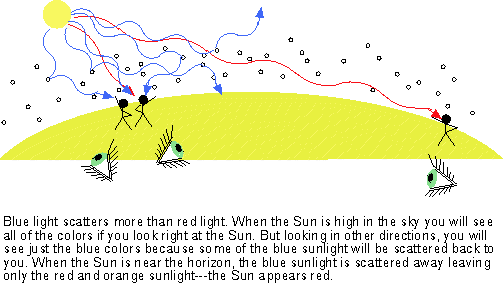
All wavelengths of light are scattered or absorbed by some amount. This
effect is called extinction. Some wavelength bands suffer more extinction
than others. Some of the infrared band can be observed from mountains above 2750
meters elevation, because the telescopes are above most of the water vapor in
the air. Carbon dioxide also absorbs a lesser amount of the infrared energy.
Gamma-rays and X-rays are absorbed by oxygen and nitrogen molecules very high
above the surface, so none of this very short wavelength radiation makes it to
within 100 kilometers of the surface. The ultraviolet light is absorbed by the
oxygen and ozone molecules at altitudes of about 60 kilometers. The longest
wavelengths of the radio band are blocked by electrons at altitudes around 200
kilometers.
The Hubble Space Telescope (HST) is able to observe in the ultraviolet,
something that ground-based research telescopes cannot do. This is one advantage
that HST will always have over ground-based telescopes, even those with adaptive
optics. Even though HST has a smaller objective than many ground-based
telescopes, its ability to observe in shorter wavelengths will keep its
resolving power very competitive with the largest ground-based telescopes with
the best adaptive optics.
Telescopes used to observe in the high-energy end of the electromagnetic
spectrum must be put above the atmosphere and require special arrangements of
their reflecting surfaces. The extreme ultraviolet and X-rays cannot be focussed
using an ordinary mirror because the high-energy photons would bury themselves
into the mirror. But if they hit the reflecting surface at a very shallow angle,
they will bounce off. Using series of concentric cone-shaped metal plates, high
energy ultraviolet and X-ray photons can be focussed to make an image.

Gamma rays have too high an energy to be focussed with even the shallow angle
reflecting technique, so gamma ray telescopes simply point in a desired
direction and count the number of photons coming from that direction. Some
examples of high-energy space observatories are shown below. Clicking on the
images will take you to sites describing the telescopes in greater detail. The
first picture is of the Extreme Ultraviolet Explorer spacecraft that observes in
the short-wavelength end of the ultraviolet band. The Roentgen Satellite (ROSAT)
is in the second picture. It observes in the X-ray band. The third picture shows
a telescope that observes the most energetic forms of electromagnetic
radiation---gamma rays. It is called the Compton Gamma Ray Observatory.
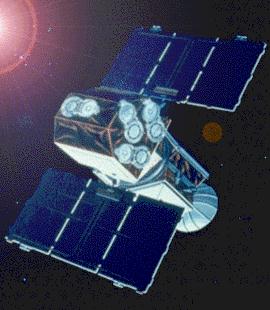
The Extreme Ultraviolet Explorer
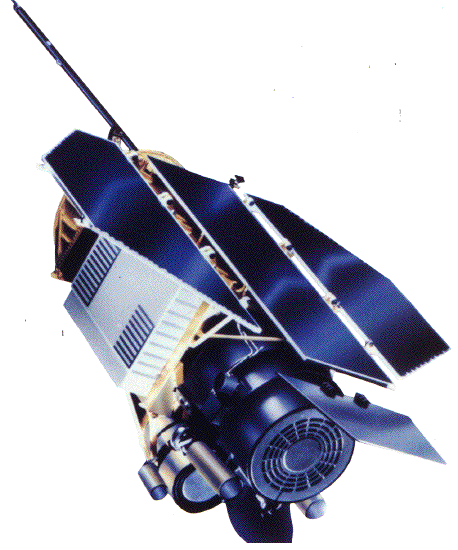
The Roentgen Satellite (ROSAT)
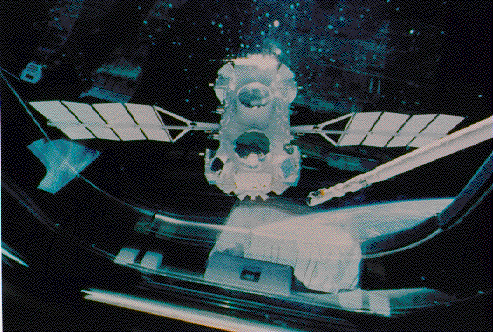
The
Compton Gamma Ray Observatory
Gases in the Earth's atmosphere can
introduce extra absorption lines into the spectra of celestial objects. The
atmospheric spectral lines must be removed from the spectroscopy data, otherwise
astronomers will find a hot star with molecular nitrogen, oxygen and water
lines! Such lines are only produced by gases much cooler than that in stars.
Vocabulary
| adaptive optics |
extinction |
reddening |
| seeing |
speckle interferometry |
- The distance to the nearest star is 4.3 light years = 4.3 × 9.7
trillion kilometers = 41,800,000,000,000 km. Does Mauna Kea's elevation of
4177 meters (=2.6 miles) put it significantly closer to even the nearest star
than something at sea level? Explain your answer. (1 kilometer = 1000 meters.)
- What causes stars to twinkle? What would make good seeing?
- Even with perfectly clear skies free of human-made pollution, the seeing
on Mauna Kea (4177 meters elevation) is much better than at sea level. Why is
that?
- What absorbs infrared light in our atmosphere and up to what height above
sea level is most of this IR absorber found?
- Even with perfectly clear skies free of human-made pollution, infrared
observations can be made at Mauna Kea but not at Kitt Peak (2070 meters
elevation). Why is that?
- Why are all ultraviolet, X-ray, and gamma ray telescopes put up in orbit?
 Go
to effects of our atmosphere section
Go
to effects of our atmosphere section
last updated 20 October 1999
Is this page a copy of
Strobel's Astronomy Notes?
Author of original content:
Nick Strobel
 The famous observing site
at the Kitt Peak National
Observatory has many large telescopes including the 4-meter Mayall telescope
(top right) and the McMath Solar Telescope (triangular one at the lower right).
Although it is over 60 kilometers from Tucson, AZ, light pollution from the
increasing population of that city has stopped the construction of any more
telescopes on the mountain.
The famous observing site
at the Kitt Peak National
Observatory has many large telescopes including the 4-meter Mayall telescope
(top right) and the McMath Solar Telescope (triangular one at the lower right).
Although it is over 60 kilometers from Tucson, AZ, light pollution from the
increasing population of that city has stopped the construction of any more
telescopes on the mountain.








